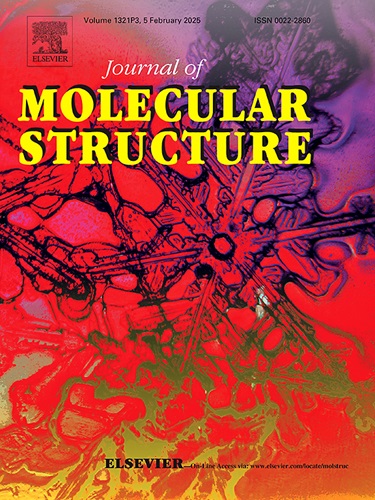Synthesis and in vitro cytotoxic evaluation of pyrazolo[1,5-c]quinazoline-triazole conjugates
IF 4
2区 化学
Q2 CHEMISTRY, PHYSICAL
引用次数: 0
Abstract
Cancer has emerged as a significant global health concern due to its high mortality rate and the threat it poses to human life. Consequently, there has been a significant focus in synthetic and medicinal chemistry on the creation, advancement, and production of powerful new anticancer compounds. This research aimed to assess the in vitro cytotoxic activity of synthesized pyrazolo[1,5-c]quinazoline-triazole conjugates against various cancer cell lines. First, several pyrazolo[1,5-c]quinazoline-triazole conjugates were synthesized. These synthesized compounds were then tested for their in vitro cytotoxic activity against the human breast cancer cell line (MCF-7) and the human lung carcinoma epithelial cell line (A549). All synthesized compounds displayed IC50 values <8 µM for both cell lines, suggesting substantial anticancer capabilities for these conjugates. Notably, the 6C4 structure exhibited superior efficacy in suppressing the growth of the MCF-7 cell line compared to Doxorubicin, a widely recognized commercial drug used as a positive control in our investigation. Furthermore, the majority of our active compounds demonstrated a low in silico toxicity risk profile, comparable to that of Doxorubicin, Gefitinib, and Lapatinib.

吡唑并[1,5-c]喹唑啉-三唑共轭物的合成及体外细胞毒性评价
由于癌症的高死亡率及其对人类生命的威胁,癌症已成为全球关注的重大健康问题。因此,合成化学和药物化学领域一直非常关注新型强效抗癌化合物的创造、发展和生产。本研究旨在评估合成的吡唑并[1,5-c]喹唑啉-三唑共轭物对多种癌细胞株的体外细胞毒性活性。首先,合成了几种吡唑并[1,5-c]喹唑啉-三唑共轭物。然后测试了这些合成化合物对人类乳腺癌细胞系(MCF-7)和人类肺癌上皮细胞系(A549)的体外细胞毒性活性。所有合成化合物对这两种细胞系的 IC50 值均为 8 µM,表明这些共轭物具有很强的抗癌能力。值得注意的是,与多柔比星相比,6C4 结构在抑制 MCF-7 细胞系生长方面表现出更高的效力,多柔比星是一种广泛认可的商业药物,在我们的研究中被用作阳性对照。此外,我们的大多数活性化合物都显示出较低的硅学毒性风险,与多柔比星、吉非替尼和拉帕替尼相当。
本文章由计算机程序翻译,如有差异,请以英文原文为准。
求助全文
约1分钟内获得全文
求助全文
来源期刊

Journal of Molecular Structure
化学-物理化学
CiteScore
7.10
自引率
15.80%
发文量
2384
审稿时长
45 days
期刊介绍:
The Journal of Molecular Structure is dedicated to the publication of full-length articles and review papers, providing important new structural information on all types of chemical species including:
• Stable and unstable molecules in all types of environments (vapour, molecular beam, liquid, solution, liquid crystal, solid state, matrix-isolated, surface-absorbed etc.)
• Chemical intermediates
• Molecules in excited states
• Biological molecules
• Polymers.
The methods used may include any combination of spectroscopic and non-spectroscopic techniques, for example:
• Infrared spectroscopy (mid, far, near)
• Raman spectroscopy and non-linear Raman methods (CARS, etc.)
• Electronic absorption spectroscopy
• Optical rotatory dispersion and circular dichroism
• Fluorescence and phosphorescence techniques
• Electron spectroscopies (PES, XPS), EXAFS, etc.
• Microwave spectroscopy
• Electron diffraction
• NMR and ESR spectroscopies
• Mössbauer spectroscopy
• X-ray crystallography
• Charge Density Analyses
• Computational Studies (supplementing experimental methods)
We encourage publications combining theoretical and experimental approaches. The structural insights gained by the studies should be correlated with the properties, activity and/ or reactivity of the molecule under investigation and the relevance of this molecule and its implications should be discussed.
 求助内容:
求助内容: 应助结果提醒方式:
应助结果提醒方式:


